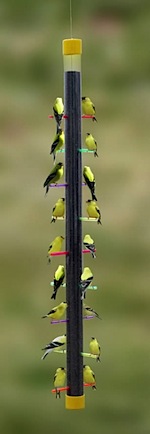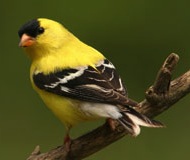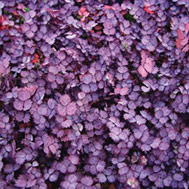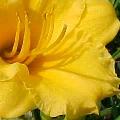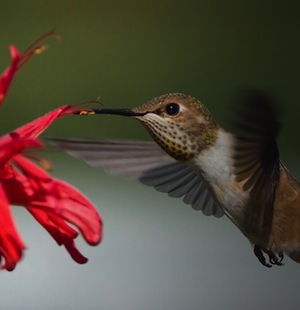-
new experience with thistle feeders
“We are just learning about the appetites of the finches.
We are already out of thistle !!! But what fun !! Jan”Recently some folks in Alexandria, LA developed an interest in backyard birding. Diving right in with a suet feeder, hopper style feeder for sunflower seed, a bird bath with mister (for summer) and two thistle feeders, the timing couldn’t have been better – for the birds and for them to witness the amazing flurry of activity this pre-spring season.
By her note above, we’re gathering they’ve got flocks of pine siskins and goldfinches in the yard right now, we sure do here in North GA.! For months thistle feeders sat, with seed going bad due to lack of activity. Then out of nowhere… tons of birds chowing down on thistle!
Also called Nyjer, thistle’s other nickname among many is “black gold” because it’s not a cheap seed to offer. A bit on the pricey side, it does have the benefit of being a non-germinating seed, one of very few seeds that won’t sprout weeds. But it’s about the only food adults will feed chicks in summer, so extra feeders (like thistle socks) and lots of seed greatly helps goldfinches thrive and flourish during their late breeding season (June and July).
Being new to the birding scene, Jan had the right idea in mind when she inquired about creating a welcoming and bird-friendly habitat in their yard. No single feeder, house, or birdbath will attract as many song birds as an overall habitat with natural food sources and shelter. And since we’re in the same planting zone, it was fairly easy to come up with a few suggestions too. Rather than re-word, and re-type the email, here’s our thoughts on cre
ating an attractive and wildlife-friendly environment.
“OK, did some research and thinking of my own yard… here are some suggestions:
Overall: Mature trees and Shrubs are very good for attracting all winged friends as not only a food source, but shelter. Since this is an open area, I’m thinking your yard must have mature trees along the back/sides? Many birds nest in trees and shrubs as they’re not all considered “cavity-dwellers” (birdhouse users).
If you’d like some kind of height or focal point around the new area, Butterfly Bush, Viburnum, Mimosa, or a Crab Apple is a great choice. These are hearty, and provide both shelter and food (nectar or fruit). Any of the native berry-producing shrubs will also provide a great food source.
Using pots for annuals is always a great option too, for color, nectar and seeds in fall!
Petunias, Zinnias, and various salvias; most garden center plants now have tags depicting if the plants provide a food source, so just look around. There should be lots of options here! You can even save seeds in the fall for replanting in spring.Cardinals, chick
adees, finches and titmice will eat seeds of many plants. The trick is not to dead-head them in fall when the urge strikes! There are lots of perennials that fit the bill in this category: coneflower, coreopsis, seedum, black-eyed susan, goldenrod, sunflowers, mexican sunflower, native salvia-(very good), coral bells,. Again look around at the garden center, and if you’re lucky… you’ll find an employee with some knowledge on the subject!
As far as for ground cover: I think mulching the area and adding plants is a better option than a solid ground cover. You’ll want to be able to get to the feeders, bath, mister and “parts” of the landscape without stepping all over things. Also, spilled seed may sprout weeds, and it’s easier to control that if not covered solid with growth.
Day lilies are a good choice, the Stella de Oro’s are quite hearty and pretty! If you wanted something more low-growing that spreads, (full sun) try purple sheep’s burr, also called purple goose leaf. In fact this would be a beautiful contrast with yellow lilies! The Stella variety tends to stay more compact as opposed to some which grow taller and appear “lanky”. Never, ever plant creeping strawberry, or ivy…these are the bane of my existence in parts of my yard 🙁 They are also a wonderful habitat for snakes, especially if you’ll have the mister going when it’s warm!
Native salvia: I’ve got a bed of this which provides color from spring through fall. Vibrant red, there are always
hummingbirds and butterflies hovering. It’s actually below one of the misters, and does well with the “extra water”. Extremely hearty, it multiplies each year, spreading roots, but does tend to grow taller, more of a back-drop. Lantana would also be a good choice if you’ve got the space for it to grow. I love perennials!
It may be helpful to actually sketch out the area on paper before planting. Drop in the plant names to get an idea. You can always do search for pics to get an idea too!
Okay… hope this helps, and as always, feel free to ping me back with questions”
-
Is there really a Cool Tube Bird Feeder out there?
Although birds won’t think so, some bird feeders are just plain boring. It’s the birds themselves who make these feeders come alive and give us so much pleasure in watching.
A very popular style is the tube. Platforms are great for versatility, and hoppers tend to have larger capacities. There’s bluebird, finch, oriole, and hummingbird feeders, and there’s peanut, fruit, seed, and suet feeders. Omg… where would one start? One feeder that’s capable of attracting several species is a great place to start. That and definitely a birdbath – even if it’s just a plant saucer with fresh water!
The cool Wave Feeder shown here accommodates black oil sunflower, which attracts a wide variety of birds. If you’re looking specifically for finches, it’s also available for thistle seed. Handcrafted in the USA of durable cedar, it’s one that will be around for many years! Although wavy is shape, it gets classified as a tube bird feeder because of the perches. Hoppers have ledges where birds perch to eat.
Not all tube feeders have perches though. Some offer “all-over” feeding with the body being screen or mesh. And a really innovative idea is the spiral tube feeder. Instead of perching or just clinging, birds actually “run the spiral” while dining. Now this may sound silly, until you’ve seen them in action! A peanut feeder is shown here, which proves tube feeders aren’t just for seed. The spirals offer options for shelled peanuts, thistle (or nyjer), and of course seed.
One other thing to consider when starting out: don’t go for the cheapest seed! It has fillers which end up on the ground and attract some less desirable birds. Spending the extra few dollars on a premium seed will absolutely bring better birds!
-
Large Capacity nyjer feeder won’t “go mushy” at the bottom
Its great when cool stuff comes along that really works! This innovative nyjer feeder is unlike any other in the way it distributes the seed. Instead of one large tube with lots of perches, The Finches Favorite 3-Tube Nyjer Feeder operates on a horizontal principle. Typically, seed sitting at the bottom of a finch or nyjer feeder does just that… it sits there and molds – then it starts to stink! And then your finches will stop visiting.
With the cost of thistle/nyjer seed these days (some refer to it as black gold) who can afford the waste? Not only does it make great sense as far as seed staying fresh longer… but all 36 birds will be in full view when this feeders’ perches are occupied. That’s a pretty impressive statement, and an even more fantastic sight to behold!
Nyjer is also unlike any other birdseed or seed mix. Its non-germinating property means no weeds sprouting, and squirrels usually leave these feeders in peace! If you feed thistle year-round, Goldfinches’ electric yellow plumage will grace the yard in summer. If you already offer thistle in your yard, an extra feeder is always helpful during Goldfinches’ busy season. The babies are fed nyjer almost exclusively. Goldfinches have one of the latest nesting seasons, so it’s not too late! Don’t forget the fresh water too, birds are drawn to this life force year-round.

